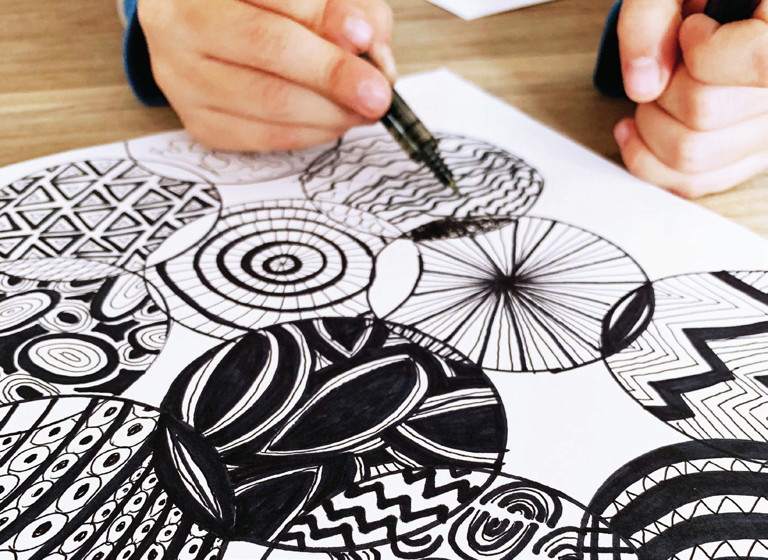MANAGING THE ART ROOM
Modes of Mindful Art-Making

A student working on a Zentangle design, an example of repetitive work.
Katie Gill-Harvey
Mindfulness is one of those words I feel like I see everywhere these days, and like with so many other popular buzzwords, it seems like there are lots of different definitions for what mindfulness actually means. For me, mindfulness is any activity that turns your attention inward and gives you a chance to really listen to the information your body, brain, and senses are trying to give you.
In our busy world, our brains are often bombarded with so much information that it can overwhelm our nervous systems, making it hard for us to recognize our own thoughts and feelings. We often see students (and adults) who seem stuck, overwhelmed, frustrated, and sometimes even angry or sad. Many people agree that this is why incorporating mindfulness practices in schools and classrooms is extremely important.
The arts provide students with opportunities to reflect and process, allowing them to express and identify the feelings they are working through each day.
The Art Room Is the Answer
This leads us to the question of how we can incorporate mindfulness in our schools. One great way is in the art room. The act of making art is unique in that it requires the simultaneous use of multiple different sensory systems. When multiple sensory systems work together, they reinforce the connections between our brains and our bodies.
The arts provide students with opportunities to reflect and process, allowing them to express and identify the feelings they are working through each day.
The act of making art is a great way to introduce students to mindfulness, and many art teachers are already doing this in their classrooms, even if they don’t realize it. I categorize mindful art-making as either repetitive work or sensory work. Both reinforce the brainbody connection that is mindfulness.
Repetitive Work
Any kind of artwork that allows students to repeat the same action or movement over and over can be described as repetitive work. Zentangle, weaving, pinch pots, crosshatching, and pointillism are all examples of repetitive work you may already do in your classroom. Our brains are constantly toggling back and forth between two states: the Task Positive Network, where our brain is on, focused, and ready to work; and the Default Mode Network, where our brains have time to think, process, and make connections.
Both networks are very important, and our brains need time in each during the day. When we’re in school or at work, we use more of our Task Positive Network brains, but we can use cues to tell our brains to take a break in the Default Mode Network. Activities like repetitive motion send a signal to our brains that it’s okay to rest.
Color Meditations
Artist Lisa Solomon writes about what she calls “Color Meditations” in her book A Field Guide to Color: A Watercolor Workbook (Shambhala, 2019). In these meditations, Solomon uses watercolors to create repetitive lines, shapes, or colors. She describes how she started using Color Meditations as a practice she could do whenever she had time, even for just a few minutes.
Inspired by Solomon, I have used Color Meditations with students as a brain break or even to ease transitions. Solomon uses watercolors for her meditations, but I’ve also done these with markers, crayons, or colored pencils.
Sensory Work
Any artwork that brings attention to the senses can be called sensory work. One of my favorite ways to do this with students of all ages is blind contour drawing, which forces us to put our full focus on what we see. I find that as I force myself to focus only on what I see with my eyes, my breathing and heart rate slow, and I begin to feel calmer. I find that students often have this same response, so I use a quick blind contour drawing activity when students seem overwhelmed.
When students seem stuck on something they are working on in class, I will suggest they do a quick blind contour drawing of something or somebody else in the room, then return to their work with fresh eyes. Helping students to focus on one particular sense allows them to take a break from thoughts, feelings, emotions, or other sensory input that may be overwhelming them.
Reflection
The arts provide many opportunities for students to reflect and process, giving them a chance to express and identify the thoughts and feelings they are working through each day. By including mindfulness-based art practices in your classroom, you help students to become conscious of those connections and see art-making as a coping strategy they can add to their own toolboxes.
RESOURCES
Tate Kids: Explore Your Feelings with Art (video): tate.org.uk/kids/explore/what-is/explore-your-feelings-with-art
“Mindful Drawing: Activities that Embrace Experimentation.” National Gallery of Art: nga.gov/stories/mindful-drawing.html
Katie Gill-Harvey is a teaching artist for the Baltimore Arts Integration Project. gillharveyk@gmail.com